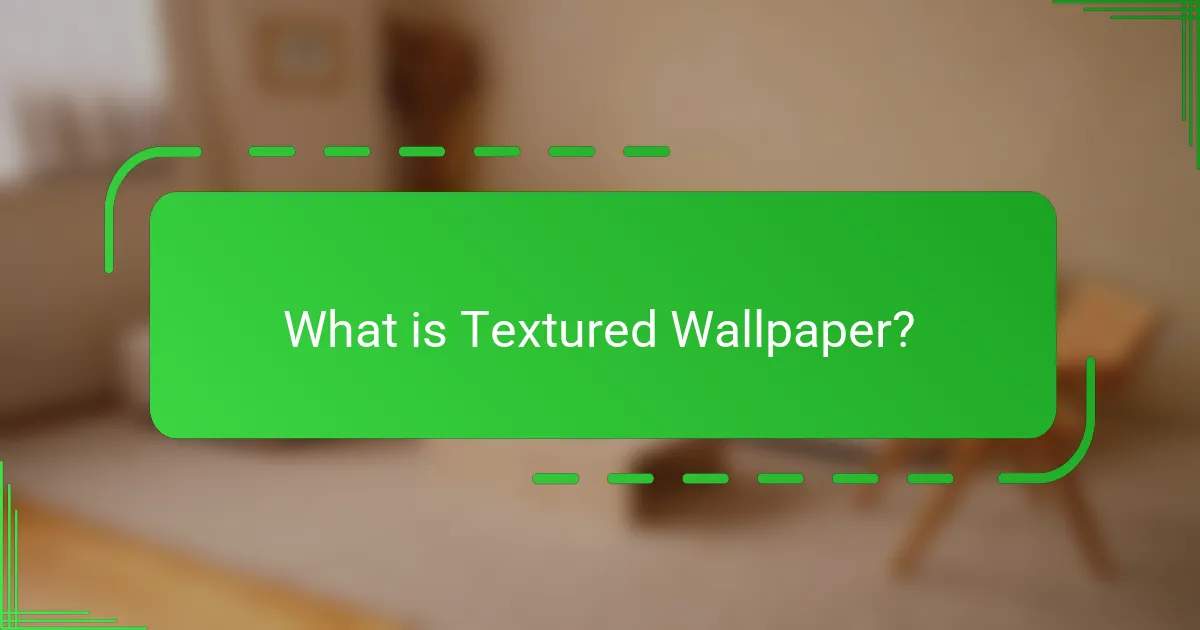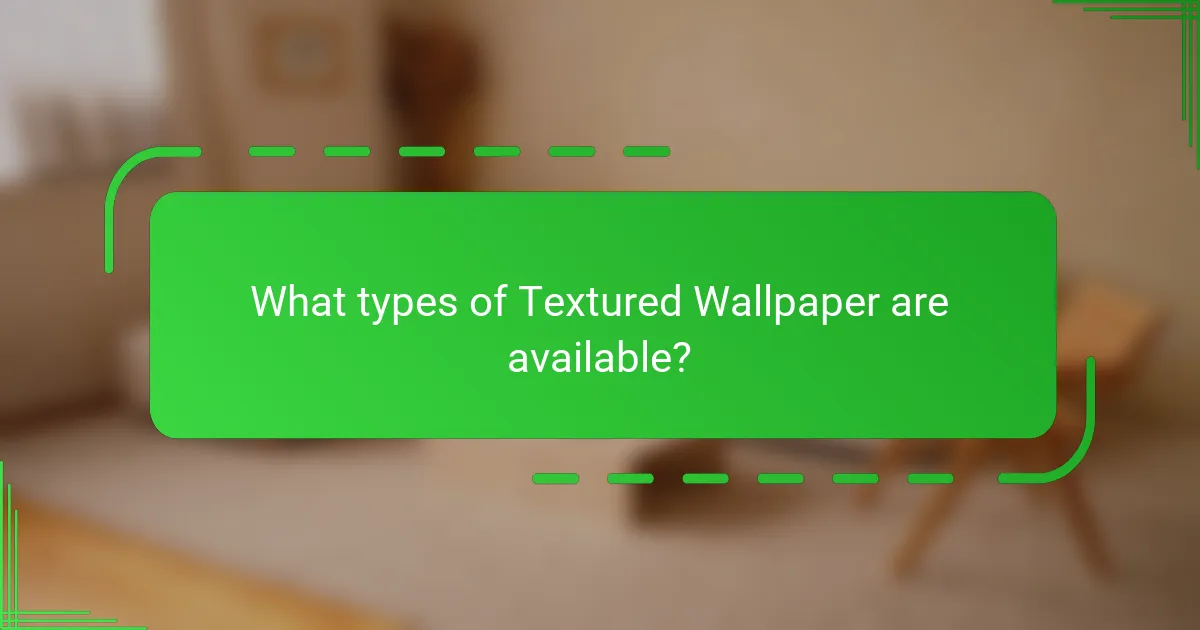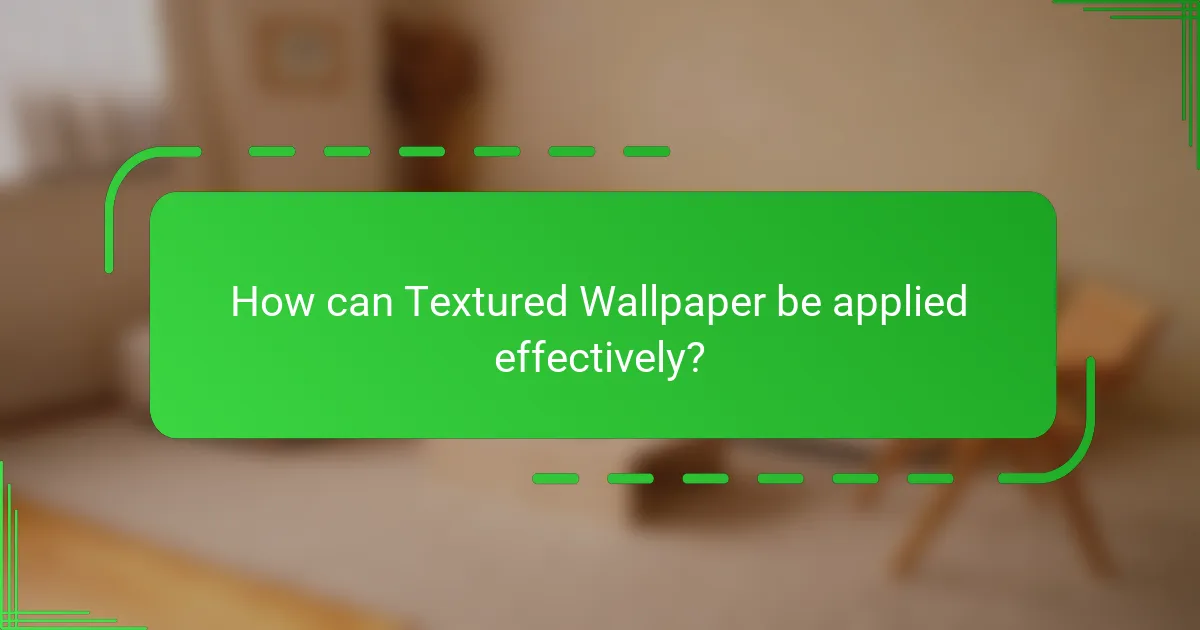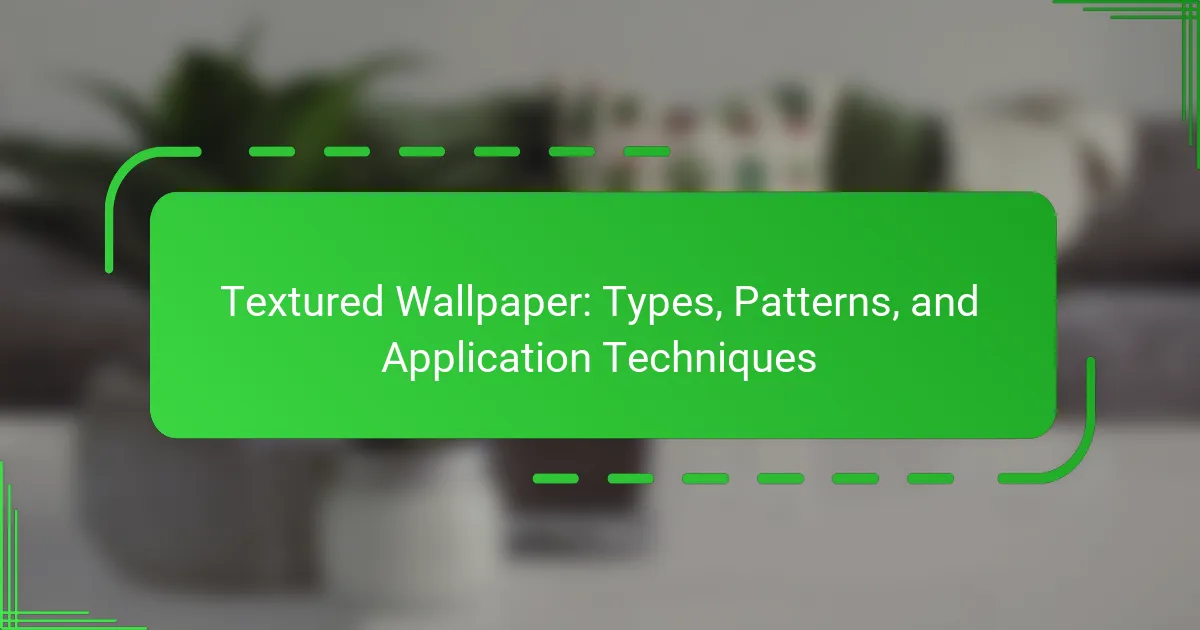Textured wallpaper is a three-dimensional wall covering that enhances the aesthetic appeal of spaces with various patterns and materials, including vinyl, fabric, and paper. It serves not only as a decorative element but also helps conceal wall imperfections. This article covers the different types of textured wallpaper, such as vinyl, fabric, grasscloth, embossed, flock, and liquid wallpaper, highlighting their unique characteristics and suitable applications. Additionally, it provides detailed application techniques to ensure a professional finish, emphasizing the importance of surface preparation and proper installation methods for longevity and visual impact.

What is Textured Wallpaper?
Textured wallpaper is a type of wall covering that features a three-dimensional surface. This surface can vary in patterns and materials, creating visual and tactile interest. Textured wallpaper is designed to enhance the aesthetic appeal of a room. Common materials include vinyl, fabric, and paper. The texture can be raised, embossed, or woven. This type of wallpaper can also help to hide imperfections on walls. It is available in various styles, from rustic to modern. Textured wallpaper is often used in residential and commercial spaces for added character.
How is Textured Wallpaper different from standard wallpaper?
Textured wallpaper differs from standard wallpaper primarily in its surface design. Standard wallpaper typically has a flat, smooth surface. Textured wallpaper features raised patterns or designs that create a three-dimensional effect. This depth adds visual interest and can enhance the overall aesthetic of a room. Textured wallpaper can also hide imperfections on walls better than standard wallpaper. Additionally, it often requires different installation techniques due to its thickness and material. Many textured wallpapers are made from vinyl or fabric, while standard options may be paper-based. This distinction influences durability and ease of cleaning. Overall, the choice between textured and standard wallpaper depends on desired aesthetics and functional needs.
What are the various textures available in Textured Wallpaper?
The various textures available in textured wallpaper include raised patterns, fabric-like finishes, and embossed designs. Raised patterns provide a three-dimensional effect that adds depth to walls. Fabric-like finishes mimic the appearance of textiles, offering a soft and tactile surface. Embossed designs create intricate patterns that enhance visual interest. Other textures include smooth, rough, and natural looks, each contributing to different aesthetic styles. Textured wallpaper can simulate materials like wood, stone, or plaster. These options allow for versatile interior design applications, catering to various tastes and preferences.
How does texture influence the overall aesthetic of a room?
Texture significantly influences the overall aesthetic of a room by adding depth and visual interest. Different textures can evoke various feelings and atmospheres. For instance, smooth surfaces often create a sleek, modern feel. Conversely, rough textures can impart warmth and coziness. Textured wallpaper can transform a flat wall into a focal point. It can also enhance or soften light, affecting the room’s ambiance. According to a study by the American Society of Interior Designers, texture is a key element in creating a balanced design. This underscores its importance in achieving a desired aesthetic.
What are the benefits of using Textured Wallpaper?
Textured wallpaper offers several benefits for interior design. It enhances visual interest by adding depth and dimension to walls. This type of wallpaper can also help to hide imperfections on surfaces. Many textured wallpapers are made from durable materials, increasing their longevity. They can improve acoustics by reducing sound transmission in a room. Textured wallpaper is available in various styles, allowing for versatile design options. Additionally, it can create a cozy atmosphere, making spaces feel more inviting. Overall, textured wallpaper combines aesthetic appeal with practical advantages.
How does Textured Wallpaper enhance interior design?
Textured wallpaper enhances interior design by adding depth and dimension to walls. It creates visual interest and can transform a flat surface into a focal point. Textured wallpaper can mimic natural materials like wood or stone, providing an organic feel to spaces. It also helps in sound absorption, improving acoustic quality in a room. Various patterns and finishes allow for personalized design choices. Additionally, textured wallpaper can hide imperfections in walls, making it a practical option. The versatility of textures supports a variety of design styles, from modern to traditional. Overall, textured wallpaper is a powerful tool in elevating interior aesthetics.
What practical advantages does Textured Wallpaper provide?
Textured wallpaper offers several practical advantages. It enhances wall aesthetics by adding depth and interest. Textured surfaces can effectively hide imperfections in walls, making them ideal for older homes. The material can improve sound insulation, contributing to a quieter environment. Additionally, textured wallpaper can provide a tactile experience, making spaces feel more inviting. It is also easier to clean than smooth wallpaper, often requiring only a damp cloth for maintenance. Furthermore, textured wallpaper can come in various designs, allowing for greater customization in interior decor.

What types of Textured Wallpaper are available?
There are several types of textured wallpaper available. These include vinyl wallpaper, which is durable and moisture-resistant. Fabric wallpaper offers a soft texture and can add warmth to a room. Grasscloth wallpaper is made from natural fibers and provides an organic look. Embossed wallpaper features raised patterns for a three-dimensional effect. Flock wallpaper has a velvety texture, enhancing the tactile experience. Liquid wallpaper is a unique option that can be applied like paint and offers a seamless finish. Each type has distinct characteristics suited for various design preferences and environments.
What are the common materials used in Textured Wallpaper?
Common materials used in textured wallpaper include vinyl, fabric, and paper. Vinyl wallpaper is durable and moisture-resistant, making it ideal for various environments. Fabric wallpaper offers a luxurious feel and unique textures, often used in upscale settings. Paper wallpaper is lightweight and easy to apply, available in a range of designs. Additionally, some textured wallpapers incorporate natural materials like grasscloth or bamboo for an organic look. Each material provides distinct aesthetic and functional benefits, catering to different preferences and applications.
How do different materials affect the durability of Textured Wallpaper?
Different materials significantly affect the durability of textured wallpaper. Vinyl wallpaper is highly durable and resistant to moisture, making it suitable for high-humidity areas. Fabric wallpaper offers a softer texture but may be less durable and more prone to staining. Paper wallpaper, while aesthetically pleasing, is often the least durable and can tear easily. Additionally, non-woven wallpaper combines the benefits of both paper and vinyl, offering durability while being easy to apply and remove. The choice of material directly impacts longevity, maintenance needs, and overall performance in various environments.
What are the environmental considerations for various materials?
Environmental considerations for various materials include sustainability, resource consumption, and recyclability. Sustainable materials minimize environmental impact during production and disposal. Resource consumption involves the extraction and processing of raw materials, which can lead to habitat destruction and pollution. Recyclability refers to the ability of materials to be repurposed after use, reducing waste in landfills. For example, natural fibers like cotton and jute are more sustainable than synthetic materials. Additionally, materials like PVC can release harmful chemicals during production and disposal. Choosing eco-friendly options, such as water-based adhesives and non-toxic inks, further reduces environmental harm.
What are the popular patterns in Textured Wallpaper?
Popular patterns in textured wallpaper include geometric designs, floral motifs, and abstract textures. Geometric patterns often feature sharp lines and angles, creating a modern aesthetic. Floral motifs add a natural element, with designs ranging from delicate to bold. Abstract textures provide depth and visual interest, often mimicking natural materials like stone or wood. Striped patterns are also common, offering a classic look that can enhance the perception of space. Additionally, damask patterns provide an elegant touch, often used in traditional decor. These patterns are widely available and can suit various interior styles.
How do patterns impact the perception of space?
Patterns significantly influence the perception of space. They can create visual effects that alter how a space is experienced. For instance, vertical stripes can make ceilings appear higher. Conversely, horizontal patterns can widen a room’s appearance. The scale of patterns also matters; large patterns can overwhelm a small space. In contrast, small patterns can create a sense of intimacy. Light colors in patterns can enhance brightness and openness. Dark patterns may make a space feel cozier but also smaller. Research shows that visual stimuli, such as patterns, affect spatial awareness and emotional responses.
What are the trending patterns in Textured Wallpaper today?
Trending patterns in textured wallpaper today include geometric designs, natural motifs, and bold colors. Geometric patterns feature sharp lines and shapes, creating a modern aesthetic. Natural motifs, such as floral and botanical designs, bring an organic feel to interiors. Bold colors, like deep greens and rich blues, are popular for making statements. Textured finishes, such as linen or raised patterns, add depth and tactile interest. According to recent market analysis, these trends reflect a shift towards personalization in home decor.

How can Textured Wallpaper be applied effectively?
Textured wallpaper can be applied effectively by ensuring a clean and smooth surface. Start by preparing the wall, filling any holes or imperfections. Next, measure and cut the wallpaper to fit the wall dimensions accurately. Apply adhesive evenly on the back of the wallpaper or directly on the wall, depending on the wallpaper type. Align the wallpaper carefully, starting from the top and working downwards. Use a smoothing tool to eliminate air bubbles and ensure a flat finish. Trim excess wallpaper at the edges for a clean look. Finally, allow the wallpaper to dry completely as per the manufacturer’s instructions. Proper preparation and technique lead to a professional appearance and longevity of the wallpaper.
What preparation is needed before applying Textured Wallpaper?
Before applying textured wallpaper, the surface must be properly prepared. Start by cleaning the wall to remove dust and grease. Ensure the wall is smooth and free from imperfections. Fill in any holes or cracks with spackle or joint compound. Sand the filled areas once dry for a level surface. Apply a primer suitable for wallpaper to enhance adhesion. Allow the primer to dry completely before proceeding. This preparation ensures the wallpaper adheres well and looks seamless.
How do you ensure a smooth application process?
To ensure a smooth application process for textured wallpaper, proper surface preparation is essential. Begin by cleaning the wall to remove dust and grease. Next, fill any holes or imperfections with spackle and sand the surface until smooth. Use a primer suitable for the wallpaper type to create an even base. Measure and cut the wallpaper accurately to avoid misalignments during application. Apply adhesive evenly and follow the manufacturer’s instructions for drying times. Use a wallpaper brush or smoothing tool to remove air bubbles and ensure proper adhesion. These steps contribute to a professional finish and enhance durability.
What tools are essential for applying Textured Wallpaper?
Essential tools for applying textured wallpaper include a wallpaper brush, a smoothing tool, a utility knife, and a paste brush. The wallpaper brush is used for applying paste and ensuring proper adhesion. A smoothing tool helps eliminate air bubbles and creases during application. A utility knife is necessary for trimming excess wallpaper at edges and corners. The paste brush is used to apply adhesive to the wallpaper or wall surface. These tools are standard in the wallpapering process and contribute to a professional finish.
What techniques are best for applying Textured Wallpaper?
The best techniques for applying textured wallpaper include proper surface preparation, measuring and cutting accurately, and using the right adhesive. Surface preparation involves cleaning and smoothing the wall to ensure good adhesion. Accurate measuring and cutting prevent waste and ensure a seamless look. Using a suitable adhesive, such as paste for vinyl or pre-pasted wallpaper, enhances the wallpaper’s longevity. Additionally, applying the wallpaper from the top down helps avoid bubbles and wrinkles. Using a smoothing tool or wallpaper brush can further ensure a smooth application. These techniques are essential for achieving a professional finish with textured wallpaper.
How can you achieve a professional finish when applying Textured Wallpaper?
To achieve a professional finish when applying textured wallpaper, start by preparing the wall surface thoroughly. Ensure the wall is clean, dry, and free from imperfections. Use a primer suitable for the wallpaper type to enhance adhesion. Measure and cut the wallpaper accurately before application. Apply adhesive evenly to both the wall and the back of the wallpaper, following the manufacturer’s instructions. Use a smoothing tool to remove air bubbles and ensure proper adhesion. Trim any excess wallpaper carefully with a sharp utility knife for clean edges. Allow the wallpaper to dry completely before touching or decorating around it. These steps are crucial for a seamless and professional appearance.
What common mistakes should be avoided during application?
Common mistakes to avoid during textured wallpaper application include improper surface preparation. Ensure the wall is clean, dry, and smooth for optimal adhesion. Another mistake is not measuring accurately. Incorrect measurements can lead to wasted materials and misaligned patterns. Additionally, failing to use the right adhesive can compromise the wallpaper’s durability. Always choose an adhesive suitable for the wallpaper type. Overlapping seams is also a frequent error. Properly align seams to create a seamless appearance. Lastly, neglecting to allow for pattern matching can disrupt the overall design. Careful planning is essential for a professional finish.
What are some tips for maintaining Textured Wallpaper?
To maintain textured wallpaper, regular cleaning is essential. Use a soft brush or a vacuum with a brush attachment to remove dust. For stains, gently wipe with a damp cloth and mild soap. Avoid harsh chemicals that can damage the texture. Ensure proper humidity levels in the room to prevent peeling or warping. Reapply adhesive if edges start to lift. Inspect for mold or mildew and treat promptly. These practices help preserve the wallpaper’s appearance and longevity.
How can you clean and care for Textured Wallpaper?
To clean and care for textured wallpaper, start by dusting it regularly with a soft cloth or a vacuum with a brush attachment. This prevents dirt buildup in the texture. For stains, use a damp sponge with mild soap and gently dab the area. Avoid scrubbing, as this can damage the wallpaper. Rinse the sponge with clean water and wipe the area to remove soap residue. Test any cleaning solution on a small, hidden area first to ensure it does not damage the wallpaper. Additionally, avoid excessive moisture, as it can lead to peeling or mold growth. Regular maintenance keeps textured wallpaper looking fresh and prolongs its lifespan.
What should you do if Textured Wallpaper gets damaged?
Repair the damaged textured wallpaper promptly. Start by assessing the extent of the damage. Minor tears can be fixed with wallpaper adhesive or glue. Apply the adhesive carefully to the edges of the tear. Press the torn section back into place and smooth it out. For larger damages, consider replacing the affected panel. Remove the damaged section by cutting it out carefully. Measure and cut a new piece of matching wallpaper. Apply adhesive to the new piece and position it correctly. Smooth out any bubbles or wrinkles after installation. Ensure that the new piece blends seamlessly with the surrounding wallpaper.
Textured wallpaper is a specialized wall covering featuring a three-dimensional surface that enhances the aesthetic appeal of interiors. This article covers the various types of textured wallpaper, including vinyl, fabric, and grasscloth, and explores their unique attributes and practical advantages. It also examines popular patterns, installation techniques, and maintenance tips, highlighting how texture influences the overall design and atmosphere of a space. Additionally, the article addresses common mistakes during application and provides solutions for maintaining and repairing textured wallpaper.
